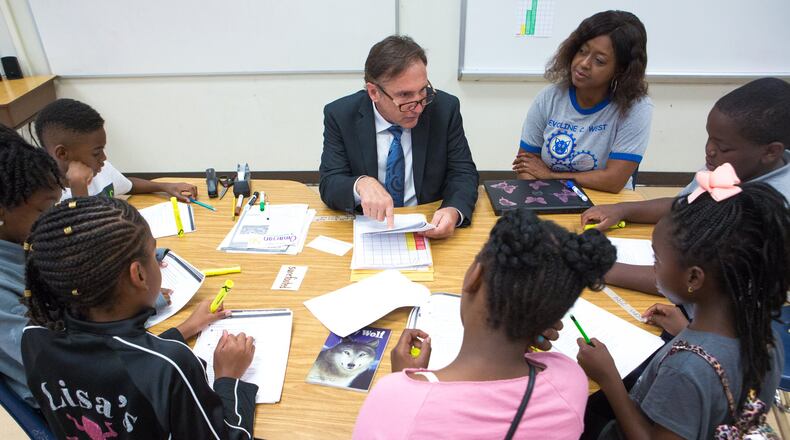After more than a year of disrupted learning, Fulton County Schools is staking $90 million on a literacy plan that will be a cornerstone of the district’s academic recovery efforts.
Leaders bill their “Every Child Reads” initiative as a “once-in-a-lifetime” push to create a culture of literacy and make up for a pandemic period in which students’ reading skills progressed much more slowly than they would in a typical year.
“We want to do something transformational and not … just do business as usual,” said Superintendent Mike Looney. “This is an opportunity to rely heavily on the research that proves that there is a scientific way to teach students to read.”
Over three years, the district plans to train thousands of employees on how best to teach reading and writing. Fulton also plans to hire 59 literacy coaches, one for each of its elementary schools, to work with students and support teachers. A new literacy director will oversee the effort, and the budget includes tools to evaluate the program’s results.
All told, the district expects to spend more than half of the $168.8 million it will receive from the American Rescue Plan on the project.
The funding represents a massive injection of money for school systems, who have flexibility in how to use it and two earlier rounds of federal stimulus. Metro Atlanta districts are devising various strategies — from lengthening the school day to expanding summer programs — to help students who fell behind or didn’t learn as much during the pandemic.
Fulton data shows that from January 2020 to January 2021, students gained about 5.3 months of reading skills, compared to the 9.5 months of progress they would make in a normal year. Middle school students, as well as the district’s Black and Hispanic children, progressed the slowest.
Looney said officials seized on the literacy program as a core part of academic recovery since reading and writing touches on all aspects of learning.
The initiative sounds like a solid strategy, so long as it incorporates long-standing as well as newer research about reading and writing, said Amanda Goodwin, associate professor in language, literacy and culture at Vanderbilt University’s Peabody College.
It could be an “amazing investment, given that they invest in the right things,” said Goodwin, also the editor of Reading Research Quarterly.
“It matters what they are emphasizing, and it matters who they bring into the room,” she said.
Some college programs don’t sufficiently prepare future teachers to teach reading, Fulton officials said. The priciest part of their plan will be providing about 80 hours of professional development to staff.
The district has not yet selected the institute or contractor that will lead the training.
Chief Academic Officer Cliff Jones said all elementary teachers will be included, plus select middle and high school teachers. The superintendent, other district leaders, substitute teachers and parent volunteers will participate.
Fulton’s program will focus on writing and five areas identified as crucial by the National Reading Panel: Phonemic awareness, phonics, fluency, vocabulary and reading comprehension.
The panel released its findings two decades ago, and the core pillars are widely taught, Goodwin said.
“The question is, ‘Are they teaching them well or not?’” she said.
She said districts also should integrate more recent research that shows the importance of critical thinking and language skills and tailor instruction to meet the needs of all students, including those for whom English is not their first language.
Fulton’s work will guide the selection of the next English language arts textbooks. It will influence classroom-level decisions, from how much time teachers spend on skills such as decoding words to the best way to structure small-group support and other reading interventions.
“It is going to shine a flashlight on what strategies we are doing and what strategies we should be doing,” Jones said.
About the Author
Keep Reading
The Latest
Featured


